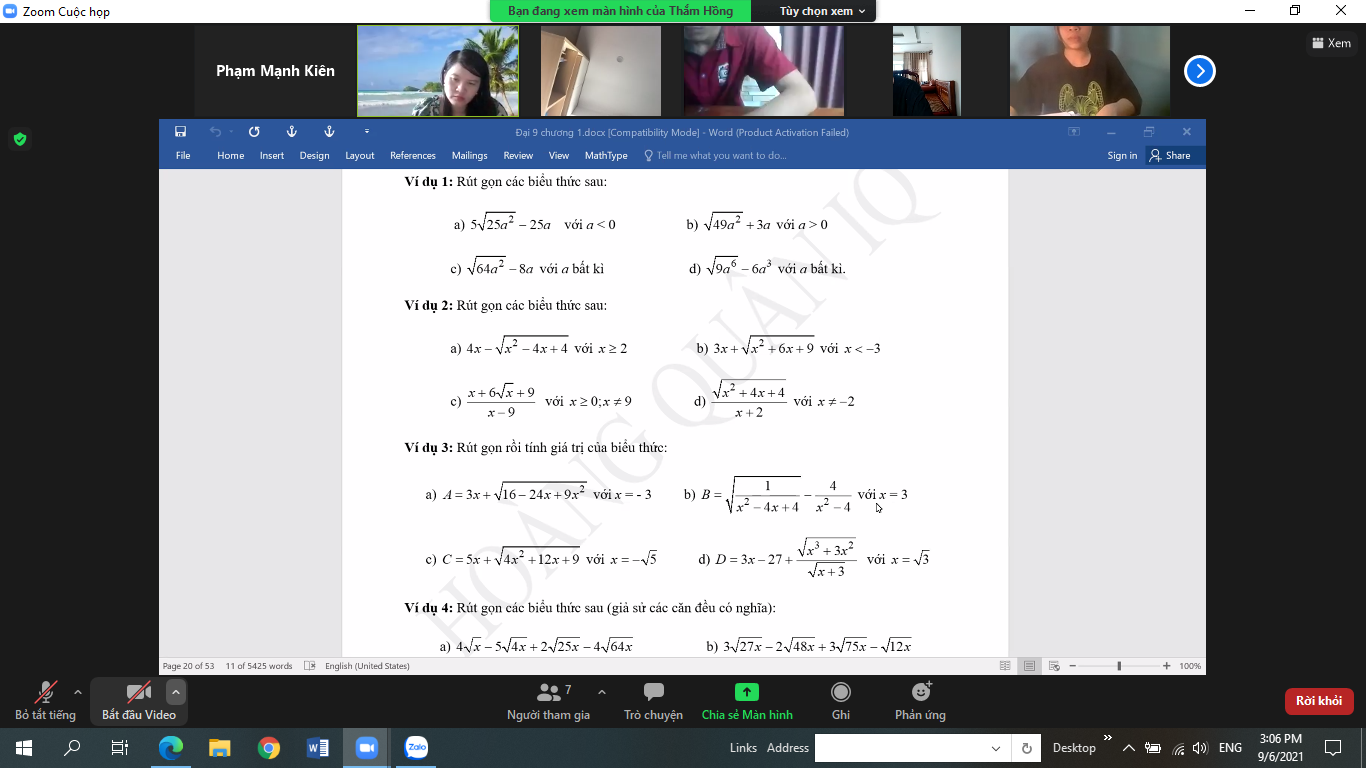Hãy nhập câu hỏi của bạn vào đây, nếu là tài khoản VIP, bạn sẽ được ưu tiên trả lời.

Theo như hình vẽ thì I là tâm đường tròn ngoại tiếp ABC và J là giao điểm MI với AO đúng không nhỉ?
Tam giác AMJ vuông tại J nên theo Pitago: \(MJ^2=MA^2-AJ^2\)
Tương tự tam giác vuông MJO: \(MJ^2=MO^2-JO^2\)
Trừ vế theo vế: \(MA^2-AJ^2-MO^2+JO^2=0\) (1)
Tam giác vuông AIJ: \(IJ^2=AI^2-AJ^2\)
Tam giác vuông \(IJO\): \(IJ^2=OI^2-JO^2\)
\(\Rightarrow AI^2-AJ^2-OI^2+JO^2=0\) (2)
Trừ vế (1) và (2): \(MA^2-AI^2-MO^2+OI^2=0\) (3)
Do O là trung điểm BC nên \(IO\perp BC\)
\(\Rightarrow OI^2+OC^2=IC^2\)
Do M, C cùng thuộc đường tròn tâm O đường kính BC \(\Rightarrow OC=OM\)
Do I là tâm đường tròn ngoại tiếp ABC \(\Rightarrow IC=IA\)
\(\Rightarrow OI^2+OM^2=IA^2\Rightarrow OI^2-IA^2=-OM^2\)
Thế vào (3):
\(MA^2-MO^2-MO^2=0\Rightarrow MA=MO\sqrt{2}=\dfrac{BC\sqrt{2}}{2}\Rightarrow BC=\sqrt{2}MA\)
Em vẽ hình ra được không nhỉ? Hiện tại đang không có công cụ vẽ hình nên không hình dung được dạng câu c

\(3,Đk:x\ge0\\ PT\Leftrightarrow\left(\sqrt{x}-2\right)\left(2\sqrt{x}-1\right)=0\\ \Leftrightarrow\left[{}\begin{matrix}\sqrt{x}=2\\\sqrt{x}=\dfrac{1}{2}\end{matrix}\right.\Leftrightarrow\left[{}\begin{matrix}x=4\left(tm\right)\\x=\dfrac{1}{4}\left(tm\right)\end{matrix}\right.\\ 7,ĐK:x\ge0\\ PT\Leftrightarrow\left(\sqrt{x+1}-\sqrt{x\left(x+1\right)}\right)+\left(\sqrt{x}-1\right)=0\\ \Leftrightarrow-\sqrt{x+1}\left(\sqrt{x}-1\right)+\left(\sqrt{x}-1\right)=0\\ \Leftrightarrow\left(\sqrt{x}-1\right)\left(1-\sqrt{x+1}\right)=0\\ \Leftrightarrow\left[{}\begin{matrix}x=1\left(tm\right)\\x+1=1\end{matrix}\right.\Leftrightarrow\left[{}\begin{matrix}x=1\\x=0\end{matrix}\right.\)
\(4,ĐK:1\le x\le\sqrt{5}\\ PT\Leftrightarrow5-x^2=x^2-2x+1\\ \Leftrightarrow x=-2\left(ktm\right)\Leftrightarrow x\in\varnothing\)

\(không\) \(dùng\) \(bđt\) \(làm\) \(sao\) \(ra\) \(được\) ??
\(\sqrt{a^2+\dfrac{1}{b^2}}=\dfrac{1}{\sqrt{17}}.\sqrt{\left(1+4^2\right)\left(a^2+\dfrac{1}{b^2}\right)}\ge\dfrac{1}{\sqrt{17}}\left(a+\dfrac{4}{b}\right)\left(bunhiacopki\right)\)
\(tương-tự:\sqrt{b^2+\dfrac{1}{c^2}}\ge\dfrac{1}{\sqrt{17}}\left(b+\dfrac{4}{c}\right)\)
\(\sqrt{c^2+\dfrac{1}{a^2}}\ge\dfrac{1}{\sqrt{17}}\left(c+\dfrac{4}{a}\right)\)
\(\Rightarrow Q\ge\dfrac{1}{\sqrt{17}}\left(a+b+c+\dfrac{4}{a}+\dfrac{4}{b}+\dfrac{4}{c}\right)=\dfrac{1}{\sqrt{17}}\left[16a+\dfrac{4}{a}+16b+\dfrac{4}{b}+16c+\dfrac{4}{c}-15\left(a+b+c\right)\right]\)
\(bđt:cosi\Rightarrow16a+\dfrac{4}{a}\ge2\sqrt{16a.\dfrac{4}{a}}=2\sqrt{16.4}=16\)
\(tương-tự\Rightarrow16b+\dfrac{4}{b}\ge16;16c+\dfrac{4}{c}\ge16\)
\(có:a+b+c\le\dfrac{3}{2}\Rightarrow15\left(a+b+c\right)\le\dfrac{45}{2}\)
\(\Rightarrow-15\left(a+b+c\right)\ge-\dfrac{45}{2}\)
\(\Rightarrow Q\ge\dfrac{1}{\sqrt{17}}\left(16+16+16-\dfrac{45}{2}\right)=\dfrac{3\sqrt{17}}{2}\)
\(dấu"="xayra\Leftrightarrow a=b=c=\dfrac{1}{2}\)
các bước ban đầu dùng bunhia chọn được 1+4^2 là do dự đoán được trước điểm rơi tại a=b=c=1/2 thôi bạn,cả bước tách dùng cosi cũng dự đoán dc điểm rơi =1/2 nên tách đc thôi
Tại sao lại k được dùng nhỉ? Trông khi dùng thì bài toán sẽ dễ giải quyết hơn
Áp dụng Bunhiacopxki:
\(\sqrt{\left(a^2+\dfrac{1}{b^2}\right)\left(\dfrac{1}{4}+4\right)}\ge\dfrac{a}{2}+\dfrac{2}{b}\)
\(\Rightarrow\sqrt{a^2+\dfrac{1}{b^2}}\ge\dfrac{2}{\sqrt{17}}\left(\dfrac{a}{2}+\dfrac{2}{b}\right)\)
Do đó:
\(Q\ge\dfrac{2}{\sqrt{17}}\left[\dfrac{a+b+c}{2}+2\left(\dfrac{1}{a}+\dfrac{1}{b}+\dfrac{1}{c}\right)\right]\)
Ta có: \(\dfrac{1}{a}+\dfrac{1}{b}+\dfrac{1}{c}\ge\dfrac{9}{a+b+c}\)
\(\Rightarrow Q\ge\dfrac{2}{\sqrt{17}}\left[\dfrac{a+b+c}{2}+\dfrac{18}{a+b+c}\right]\)
Áp dụng Cô-si:
\(\dfrac{a+b+c}{2}+\dfrac{9}{8\left(a+b+c\right)}\ge\dfrac{3}{2}\)
Do đó:
\(Q\ge\dfrac{2}{\sqrt{17}}\left[\dfrac{3}{2}+\dfrac{135}{8\left(a+b+c\right)}\right]\ge\dfrac{2}{\sqrt{17}}\left[\dfrac{3}{2}+\dfrac{135}{8.\dfrac{3}{2}}\right]=\dfrac{3\sqrt{17}}{2}\)
Dấu "=" xảy ra khi \(a=b=c=\dfrac{1}{2}\)

\(\left\{{}\begin{matrix}\dfrac{1}{x}+\dfrac{1}{y}=\dfrac{5}{6}\\\dfrac{\dfrac{2}{3}}{x}+\dfrac{\dfrac{2}{3}}{y}+\dfrac{\dfrac{8}{9}}{y}=1\end{matrix}\right.\)\(\Leftrightarrow\left\{{}\begin{matrix}\dfrac{1}{x}+\dfrac{1}{y}=\dfrac{5}{6}\\\dfrac{\dfrac{2}{3}}{x}+\dfrac{\dfrac{14}{9}}{y}=1\end{matrix}\right.\)\(\Leftrightarrow\left\{{}\begin{matrix}\dfrac{1}{x}+\dfrac{1}{y}=\dfrac{5}{6}\left(1\right)\\\dfrac{2}{3x}+\dfrac{14}{9y}=1\left(2\right)\end{matrix}\right.\)
Nhân cả hai vế (1) cho \(\dfrac{2}{3}\) ta có: \(\left\{{}\begin{matrix}\dfrac{2}{3x}+\dfrac{2}{3y}=\dfrac{5.2}{6.3}\\\dfrac{2}{3x}+\dfrac{14}{9y}=1\end{matrix}\right.\)\(\Leftrightarrow\left\{{}\begin{matrix}\dfrac{2}{3x}+\dfrac{2}{3y}=\dfrac{10}{18}\left(3\right)\\\dfrac{2}{3x}+\dfrac{14}{9y}=1\left(4\right)\end{matrix}\right.\)
Lấy (4) trừ (3) ta có:
\(\dfrac{14}{9y}-\dfrac{2}{3y}=1-\dfrac{10}{18}\)\(\Leftrightarrow\dfrac{8}{9y}=\dfrac{4}{9}\)\(\Leftrightarrow y=2\Rightarrow x=\dfrac{1}{\dfrac{5}{6}-\dfrac{1}{2}}=3\)

a: \(\sqrt{252}+\dfrac{1}{3}\sqrt{63}-\sqrt{175}\)
\(=4\sqrt{7}+\sqrt{7}-5\sqrt{7}\)
=0

có
\(\left\{{}\begin{matrix}3x-y=2\\5x+y=6\end{matrix}\right.\\ < =>\left\{{}\begin{matrix}y=3x-2\\y=6-5x\end{matrix}\right.\\ =>3x-2=6-5x\\ < =>8x=8\\ < =>x=1\\ =>y=3\cdot1-2=1\\ =>\left\{{}\begin{matrix}x=1\\y=1\end{matrix}\right.\)
\(\left\{{}\begin{matrix}3x-y=2\\5x+y=6\end{matrix}\right.\)
\(\Leftrightarrow\left\{{}\begin{matrix}3x-y=2\\8x=8\end{matrix}\right.\) (Ta có: \(\left(3x+5x\right)+\left(-y+y\right)=2+6\))
\(\Leftrightarrow\left\{{}\begin{matrix}3x-y=2\\x=\dfrac{8}{8}=1\end{matrix}\right.\)
\(\Leftrightarrow\left\{{}\begin{matrix}3\cdot1-y=2\\x=1\end{matrix}\right.\)
\(\Leftrightarrow\left\{{}\begin{matrix}3-y=2\\x=1\end{matrix}\right.\)
\(\Leftrightarrow\left\{{}\begin{matrix}y=3-2\\x=1\end{matrix}\right.\)
\(\Leftrightarrow\left\{{}\begin{matrix}y=1\\x=1\end{matrix}\right.\)
Vậy căp (x;y) thỏa mãn là (1;1)




ĐKXĐ: \(x\ge\dfrac{1}{2}\)
\(\Leftrightarrow2x-2\sqrt{2x^2+5x-3}=1+x\left(\sqrt{2x-1}-2\sqrt{x+3}\right)\)
\(\Leftrightarrow2x-1-2\sqrt{\left(2x-1\right)\left(x+3\right)}-x\left(\sqrt{2x-1}-2\sqrt{x+3}\right)=0\)
\(\Leftrightarrow\sqrt{2x-1}\left(\sqrt{2x-1}-2\sqrt{x+3}\right)-x\left(\sqrt{2x-1}-2\sqrt{x+3}\right)=0\)
\(\Leftrightarrow\left(\sqrt{2x-1}-x\right)\left(\sqrt{2x-1}-2\sqrt{x+3}\right)=0\)
\(\Leftrightarrow\left[{}\begin{matrix}\sqrt{2x-1}=x\left(x\ge0\right)\\\sqrt{2x-1}=2\sqrt{x+3}\end{matrix}\right.\)
\(\Rightarrow\left[{}\begin{matrix}2x-1=x^2\\2x-1=4\left(x+3\right)\end{matrix}\right.\)
\(\Rightarrow\left[{}\begin{matrix}x=1\\x=-\dfrac{13}{2}\left(loại\right)\end{matrix}\right.\)